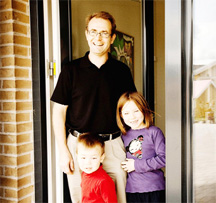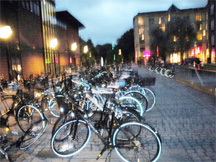Given all that is known about temperate climes, one would assume that achieving energy efficiency in homes in a country like Denmark might be difficult. But Bo Andersen and his family, who opened their well-insulated, low-energy house to a slew of foreign editors last week, know differently.

The Andersens live in a house on Mosekaeret 7 in the low-energy settlement of Stenlose South, part of the Egedal Municipality on the outskirts of Copenhagen. They boast that they are able to save vast amounts of CO2 while at the same time enjoying a better quality of life.
“We really enjoy our new home,” Bo Andersen said. “We have a great indoor climate, completely draught proof. But on top of that we have a low energy bill due to the efficient insulation, the triple-glazed windows and the modern ventilation system used in our house.”

The house, which was completed last year, has four bedrooms, two bathrooms, a study, a living room, a scullery and an adjoining garage. It is home to Bo Andersen, who is an engineer; his wife Katrine, who is a chemist and their two children, seven-year-old Karen and three-year-old Ebsen.
The entire community of Stenlose South is low energy and it is referred to as Europe’s largest low-energy area. It was in 2003 that the city council of Egedal Municipality decided unanimously to pioneer energy savings, and earmarked an urban area – Stenlose South – for the construction of 750 low-energy buildings.
There was no precedence for such a project and in order to get it up and running, the Egedal Municipality was forced to purchase the land in Stenlose South and re-sell it to the citizens. However two years ago, the Danish government passed legislation to make it easier for municipalities to make legal requirements for low-energy buildings. The Egedal City Council has now decided that all future buildings within the municipality will be required to be built as ‘low-energy class 1’, the strictest within Danish legislation, with the only exceptions being privately built single family houses.
The Andersens’ house is described as one of the “high-end constructions” in Stenlose South. The house and garage cost a total of DKK 2.6 million (US$518,297.64 or $106,613,540).
While this seems expensive, the Andersens’ monthly heating bill is now only DKK 500 (US$99.67/$20,503) – a mere third of what they would have paid if their house was not low energy. The home has insulation, triple-glazed windows with low-energy gas filling, a ventilation system with heat-recovery (utilising the warm, humid air to pre-heat the fresh air intake from the outside), 5 m2 solar panel on the roof, geothermal ground heat pump, central air-to-air heat pump, water tank for the collection of rainwater used for flushing the toilets and washing machine to save ground water reserves and relieve the sewage system during intense rainfall. It contains no PVC and no pressure-creosoted wood and is as green as it gets.

There are smaller homes and apartments, built as cost-efficient social housing, using the same technology as the Andersens’ home which do not cost as much; evidence that low-energy technology can also help fight energy poverty in vulnerable households. The low-energy concept is even used in the local kindergarten. Stenlose South has become a model community in Europe, where the Andersens and their neighbours demonstrate daily how to build a better future.
It is estimated that modern buildings can consume some 40% of energy – mostly for heating, cooling and ventilation. This is a fact that many homeowners/builders, even in the tropics, do not tend to consider. Their focus is on cost saving during construction, not realising that in the longer term, a poorly ventilated home, school or office can prove to be staggeringly expensive, and injurious to health.
Apart from the amazing Stenlose municipal project, Denmark has seriously taken up the challenge to end global warming. It has gone from being 99% dependent on sources of foreign oil to becoming completely energy self sufficient. The turning point was the 1973 oil crisis, during which many Danes could not have heated their homes.
Denmark is also way ahead of most other nations in the use of renewable energy technology and sustainable climate solutions and well on the way to being green. Windmill farms dot certain points of the horizon and almost half the world’s wind turbines are produced by Danish manufacturers. The country is now producing hydrogen, using surplus wind power to electrolyze water. Apart from exporting green technology, Danes, perhaps half of the population of Copenhagen, and in other areas as well, own bicycles and ride them to work, school and other places every day.
Having taken a conscious decision to host the United Nations Climate Change Conference, COP15, in December, the Danish government will use the opportunity to demonstrate to the world just what is possible.





